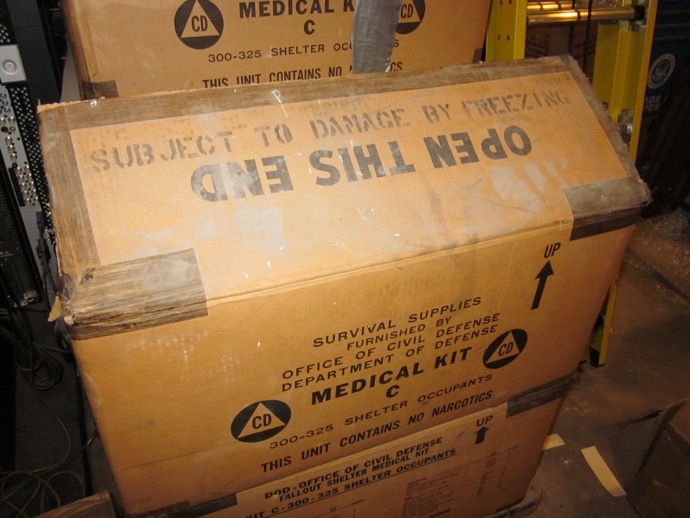Survival Stockpiles and Rations: Lessons from the Cold War

There were over 100,000 municipal survival shelters scattered across the country from 1960s to the early 1970s. They were funded by the federal government, but sites were selected and managed by state and local civil defense agencies. Considering that these shelters were intended to protect populations from the effects of a nuclear war, it’s almost comical to see how ineffective they really were. However, looking back can show us how far we’ve come in the arena of survival preparedness as well as some major shortcomings that we still face.
Rations

We used to eat a lot less back then. Government officials as well as health experts concluded that we only needed a small fraction of the calories to sustain the population compared with today. In fact, rations were packaged to provide only 700 calories per day, per person for a period of two weeks. The bulk of these calories came in the form of crackers, because the general consensus was that carbohydrates were all we needed to keep our bodies functioning properly.
Strict limitations as to how many crackers, wafers, biscuits and carbohydrate supplements were imposed. Ironically, the carbohydrate supplements were little pieces of candy that included dyes that were found to cause cancer. Each survival box had a certain amount of cans that contained a specified number of pieces of food. Each person would be allowed to take x amount of items from box 1, x amount of items from box 2 and so on.
Feedings were supposed to occur at specified times a day, and supplies were supposed to last for a two week period. This was supposed to provide enough time for the government to establish shelters and re-supply options following a devastating nuclear exchange.
50 People
These rations were part of a survival package that figured 50 people would be in each shelter. Five people would share a water barrel for two weeks. Each person got a sanitation kit and the shelter had to share a limited amount of first aid supplies. Shelters were also given a radiation detector and ventilation kits.
It was assumed that these supplies could last for decades. An audit in 1970 was conducted with the impression that these supplies could be used as supplements to better options that emerged over the course of time. However, testing revealed that many of these supplies have spoiled, became inedible or ineffective. Consequently, the US government decided to give the rotten food to animal feed producers and mix it in with their daily meals.
Medical supplies, particularly medications also “deteriorated” badly and needed to be disposed of properly. One of the items in the first aid supply kit was phenobarbital, and municipalities were encouraged to locate stocks and hand them over to appropriate government agencies for disposal. Not surprisingly, many of these stocks were never accounted for.
Most sanitation kits included 10 rolls of toilet paper, about one sanitary napkin for each person, a cup, commode and a handful of toilet liners. No soap, no deodorant, no razors. The kit also included some disinfectant and cleaning products that were later found to be susceptible to temperature fluctuations. This would cause their chemical composition to change, and it was not uncommon for the products to leak through the containers. Early versions of hand-sanitizers were also found to be defective, harmful to the skin and leech through their containers as well.
Medical kits included a limited amount of things like eye drops, petroleum jelly, aspirin, bandages, rubbing alcohol, a thermometer and pair of scissors. Each kit contained a handful of water purification tablets, iodine, baking soda and surgical soap. Hardly what a group of 50 people would need in the aftermath of a nuclear exchange.
Different Times, Same Problems

It is safe to say that people trusted the government a lot more in the 1960s, and that the masses followed the guidelines that were prescribed. However, in hindsight, we know that to not be true. In fact, much of the advice that the government gave with respect to nuclear war was complete nonsense. It is clear today, that these measures were provided as a way to give people the illusion of safety and to prevent panic.
What hasn’t changed much is that the government’s response to disasters falls on similar lines. Inadequate resources, planning and advice is the rule more than the exception. They are designed to keep people pacified, to keep the economy moving and to prevent us from asking too many questions. Governmental disaster resources are also very limited, and it’s a foregone conclusion that we need to take matters into our own hands.
Of course, many households during the Cold War also built their own shelters and stocked up on supplies. However, it goes without saying that most people had no clue as to what to expect from a full-scale nuclear exchange, and even their best efforts would probably amount to nothing in the end.
The moral of this story is that it’s up to us to think critically and never accept what the government says as being true. It’s our responsibility to provide for our own safety and well-being, and to be ready to weather any survival situation that comes our way. We may be a long way off from the height of the Cold War, but we face more threats than ever before. How prepared are you?














